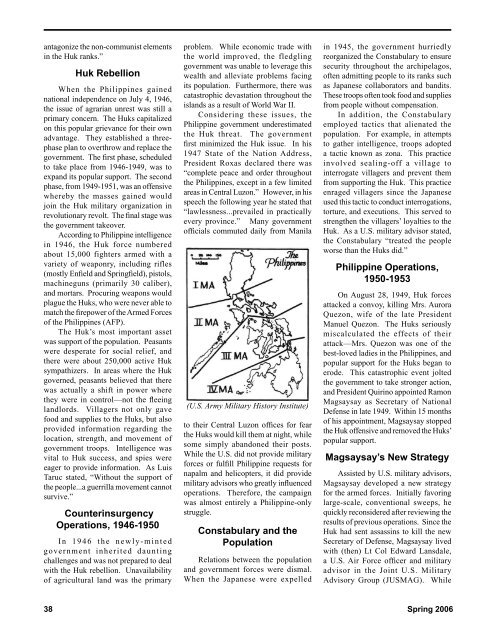Philippine Information Operations During The Hukbalahap ...
Philippine Information Operations During The Hukbalahap ...
Philippine Information Operations During The Hukbalahap ...
You also want an ePaper? Increase the reach of your titles
YUMPU automatically turns print PDFs into web optimized ePapers that Google loves.
antagonize the non-communist elements<br />
in the Huk ranks.”<br />
Huk Rebellion<br />
When the <strong>Philippine</strong>s gained<br />
national independence on July 4, 1946,<br />
the issue of agrarian unrest was still a<br />
primary concern. <strong>The</strong> Huks capitalized<br />
on this popular grievance for their own<br />
advantage. <strong>The</strong>y established a threephase<br />
plan to overthrow and replace the<br />
government. <strong>The</strong> first phase, scheduled<br />
to take place from 1946-1949, was to<br />
expand its popular support. <strong>The</strong> second<br />
phase, from 1949-1951, was an offensive<br />
whereby the masses gained would<br />
join the Huk military organization in<br />
revolutionary revolt. <strong>The</strong> final stage was<br />
the government takeover.<br />
According to <strong>Philippine</strong> intelligence<br />
in 1946, the Huk force numbered<br />
about 15,000 fighters armed with a<br />
variety of weaponry, including rifles<br />
(mostly Enfield and Springfield), pistols,<br />
machineguns (primarily 30 caliber),<br />
and mortars. Procuring weapons would<br />
plague the Huks, who were never able to<br />
match the firepower of the Armed Forces<br />
of the <strong>Philippine</strong>s (AFP).<br />
<strong>The</strong> Huk’s most important asset<br />
was support of the population. Peasants<br />
were desperate for social relief, and<br />
there were about 250,000 active Huk<br />
sympathizers. In areas where the Huk<br />
governed, peasants believed that there<br />
was actually a shift in power where<br />
they were in control—not the fleeing<br />
landlords. Villagers not only gave<br />
food and supplies to the Huks, but also<br />
provided information regarding the<br />
location, strength, and movement of<br />
government troops. Intelligence was<br />
vital to Huk success, and spies were<br />
eager to provide information. As Luis<br />
Taruc stated, “Without the support of<br />
the people...a guerrilla movement cannot<br />
survive.”<br />
Counterinsurgency<br />
<strong>Operations</strong>, 19 6-1950<br />
I n 1 9 4 6 t h e n e w l y - m i n t e d<br />
government inherited daunting<br />
challenges and was not prepared to deal<br />
with the Huk rebellion. Unavailability<br />
of agricultural land was the primary<br />
problem. While economic trade with<br />
the world improved, the fledgling<br />
government was unable to leverage this<br />
wealth and alleviate problems facing<br />
its population. Furthermore, there was<br />
catastrophic devastation throughout the<br />
islands as a result of World War II.<br />
Considering these issues, the<br />
<strong>Philippine</strong> government underestimated<br />
the Huk threat. <strong>The</strong> government<br />
first minimized the Huk issue. In his<br />
1947 State of the Nation Address,<br />
President Roxas declared there was<br />
“complete peace and order throughout<br />
the <strong>Philippine</strong>s, except in a few limited<br />
areas in Central Luzon.” However, in his<br />
speech the following year he stated that<br />
“lawlessness...prevailed in practically<br />
every province.” Many government<br />
officials commuted daily from Manila<br />
(U.S. Army Military History Institute)<br />
to their Central Luzon offices for fear<br />
the Huks would kill them at night, while<br />
some simply abandoned their posts.<br />
While the U.S. did not provide military<br />
forces or fulfill <strong>Philippine</strong> requests for<br />
napalm and helicopters, it did provide<br />
military advisors who greatly influenced<br />
operations. <strong>The</strong>refore, the campaign<br />
was almost entirely a <strong>Philippine</strong>-only<br />
struggle.<br />
Constabulary and the<br />
Population<br />
Relations between the population<br />
and government forces were dismal.<br />
When the Japanese were expelled<br />
in 1945, the government hurriedly<br />
reorganized the Constabulary to ensure<br />
security throughout the archipelagos,<br />
often admitting people to its ranks such<br />
as Japanese collaborators and bandits.<br />
<strong>The</strong>se troops often took food and supplies<br />
from people without compensation.<br />
In addition, the Constabulary<br />
employed tactics that alienated the<br />
population. For example, in attempts<br />
to gather intelligence, troops adopted<br />
a tactic known as zona. This practice<br />
involved sealing-off a village to<br />
interrogate villagers and prevent them<br />
from supporting the Huk. This practice<br />
enraged villagers since the Japanese<br />
used this tactic to conduct interrogations,<br />
torture, and executions. This served to<br />
strengthen the villagers’ loyalties to the<br />
Huk. As a U.S. military advisor stated,<br />
the Constabulary “treated the people<br />
worse than the Huks did.”<br />
<strong>Philippine</strong> <strong>Operations</strong>,<br />
1950-1953<br />
On August 28, 1949, Huk forces<br />
attacked a convoy, killing Mrs. Aurora<br />
Quezon, wife of the late President<br />
Manuel Quezon. <strong>The</strong> Huks seriously<br />
miscalculated the effects of their<br />
attack—Mrs. Quezon was one of the<br />
best-loved ladies in the <strong>Philippine</strong>s, and<br />
popular support for the Huks began to<br />
erode. This catastrophic event jolted<br />
the government to take stronger action,<br />
and President Quirino appointed Ramon<br />
Magsaysay as Secretary of National<br />
Defense in late 1949. Within 15 months<br />
of his appointment, Magsaysay stopped<br />
the Huk offensive and removed the Huks’<br />
popular support.<br />
Magsaysay’s New Strategy<br />
Assisted by U.S. military advisors,<br />
Magsaysay developed a new strategy<br />
for the armed forces. Initially favoring<br />
large-scale, conventional sweeps, he<br />
quickly reconsidered after reviewing the<br />
results of previous operations. Since the<br />
Huk had sent assassins to kill the new<br />
Secretary of Defense, Magsaysay lived<br />
with (then) Lt Col Edward Lansdale,<br />
a U.S. Air Force officer and military<br />
advisor in the Joint U.S. Military<br />
Advisory Group (JUSMAG). While<br />
8 Spring 2006
















